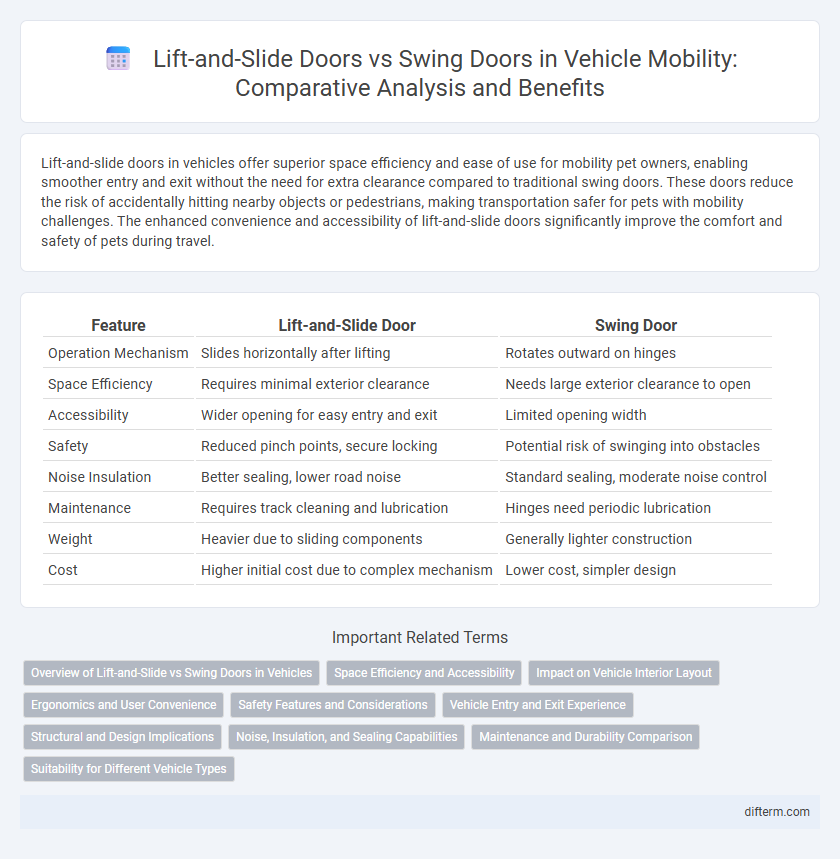Lift-and-slide doors in vehicles offer superior space efficiency and ease of use for mobility pet owners, enabling smoother entry and exit without the need for extra clearance compared to traditional swing doors. These doors reduce the risk of accidentally hitting nearby objects or pedestrians, making transportation safer for pets with mobility challenges. The enhanced convenience and accessibility of lift-and-slide doors significantly improve the comfort and safety of pets during travel.
Table of Comparison
| Feature | Lift-and-Slide Door | Swing Door |
|---|---|---|
| Operation Mechanism | Slides horizontally after lifting | Rotates outward on hinges |
| Space Efficiency | Requires minimal exterior clearance | Needs large exterior clearance to open |
| Accessibility | Wider opening for easy entry and exit | Limited opening width |
| Safety | Reduced pinch points, secure locking | Potential risk of swinging into obstacles |
| Noise Insulation | Better sealing, lower road noise | Standard sealing, moderate noise control |
| Maintenance | Requires track cleaning and lubrication | Hinges need periodic lubrication |
| Weight | Heavier due to sliding components | Generally lighter construction |
| Cost | Higher initial cost due to complex mechanism | Lower cost, simpler design |
Overview of Lift-and-Slide vs Swing Doors in Vehicles
Lift-and-slide doors in vehicles offer a sleek, space-saving design that enhances ease of access by sliding parallel to the vehicle body, making them ideal for tight parking spaces. Swing doors, traditional in many car models, pivot outward to provide wide entry space but require more clearance, which can be challenging in confined areas. Comparing lift-and-slide and swing doors highlights trade-offs between space efficiency, accessibility, and vehicle design flexibility.
Space Efficiency and Accessibility
Lift-and-slide doors offer superior space efficiency in vehicles by sliding parallel to the body, eliminating the need for clearance space required by swing doors. This design enhances accessibility, especially in tight urban environments or parking situations, allowing easier entry and exit. Swing doors provide traditional access but can be restrictive in confined spaces due to their outward opening arc.
Impact on Vehicle Interior Layout
Lift-and-slide doors optimize vehicle interior space by sliding parallel to the body, allowing easier access without reducing cabin area. Swing doors require clearance to open outward, limiting design flexibility and potentially obstructing adjacent spaces in tight environments. This distinction influences seating arrangements and passenger movement efficiency within the vehicle.
Ergonomics and User Convenience
Lift-and-slide doors in vehicles enhance ergonomics by reducing the physical effort required to open and close, providing smooth, space-saving operation ideal for tight parking spaces. Swing doors demand more clearance and can be cumbersome in confined areas, potentially causing discomfort or inconvenience to users. The lift-and-slide mechanism improves user convenience through effortless handling and better accessibility, especially for passengers with limited mobility.
Safety Features and Considerations
Lift-and-slide doors in vehicles offer enhanced safety by reducing the risk of accidental door openings during motion and providing a secure sealing mechanism against external elements. Swing doors, while traditional, pose higher risks in tight spaces due to their wider opening arc, increasing the potential for collision or injury. Modern lift-and-slide systems often incorporate electronic locking and sensor technologies to improve passenger safety and ease of use compared to conventional swing door designs.
Vehicle Entry and Exit Experience
Lift-and-slide doors provide a smoother and more spacious entry and exit experience by gliding along the vehicle frame, reducing the space needed for opening compared to traditional swing doors. This design minimizes obstruction in tight parking spaces and enhances accessibility for passengers, especially in urban environments. Swing doors, while offering a familiar and straightforward mechanism, can be cumbersome in confined areas and may pose challenges for individuals with limited mobility.
Structural and Design Implications
Lift-and-slide doors in vehicles offer enhanced structural rigidity due to their interlocking mechanisms and reinforced frames, which improve safety and reduce chassis flex. Swing doors require robust hinge systems and impact-resistant side panels to maintain structural integrity, often increasing vehicle weight and complexity. The compact design of lift-and-slide doors also maximizes cabin space efficiency and improves aerodynamics compared to the traditional swing door layout.
Noise, Insulation, and Sealing Capabilities
Lift-and-slide doors in vehicles offer superior sealing capabilities compared to swing doors, significantly reducing noise intrusion from external environments. Their advanced insulation properties enhance thermal regulation, contributing to a quieter and more climate-controlled cabin. Swing doors, while easier to operate in tight spaces, typically provide less effective sealing, resulting in higher susceptibility to sound leakage and temperature fluctuations.
Maintenance and Durability Comparison
Lift-and-slide doors in vehicles offer superior sealing and reduced mechanical wear compared to swing doors, resulting in lower maintenance requirements and enhanced durability under frequent use. The sliding mechanism, typically equipped with robust rollers and tracks, experiences less stress from door swings and impacts, minimizing component replacement and adjustment needs. In contrast, swing doors often face higher hinge wear and alignment issues, increasing maintenance frequency and reducing long-term reliability in demanding mobility environments.
Suitability for Different Vehicle Types
Lift-and-slide doors offer enhanced space efficiency and easier access, making them ideal for compact and electric vehicles where maximizing interior space and minimizing door swing radius are crucial. Swing doors are better suited for larger vehicles such as SUVs and trucks, providing robust sealing and simpler mechanical design for durability in rugged conditions. Electric and autonomous vehicles increasingly adopt lift-and-slide mechanisms to optimize passenger entry in tight urban environments and improve aerodynamic performance.
lift-and-slide door vs swing door (in vehicles) Infographic

 difterm.com
difterm.com